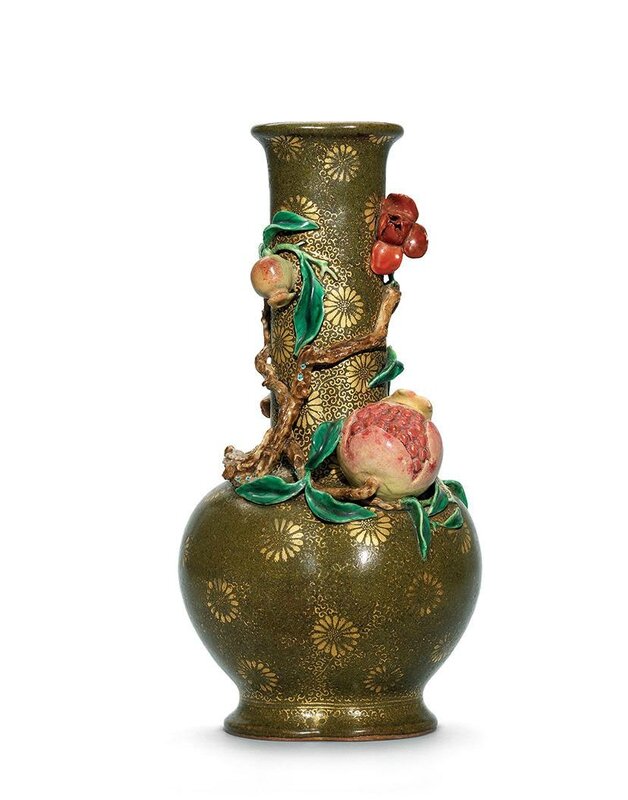A rare famille rose and gilt-decorated teadust-glazed ‘pomegranate’ vase, Qianlong six-character seal mark and of the period
Lot 3244. A rare famille rose and gilt-decorated teadust-glazed ‘pomegranate’ vase, Qianlong six-character seal mark and of the period (1736-1795). Estimate HK$5,500,000-7,500,000 ($720,000-970,000). Unsold. Photo Christie's Image Ltd 2016.
The vase is finely potted with a tri-lobed globular body rising to a long neck with an everted lip, supported on a splayed foot, applied to the shoulder and neck in high relief with a moulded branch bearing pomegranate flowers and fruits, some fruits split open to expose the seeds inside, and a spray of lingzhi fungi. The vase is covered overall with a speckled, teadust-green glaze gilt-decorated with scrolling chrysanthemum throughout. The base is covered with a teadust glaze, reserving in the centre the reign mark applied with a brown wash. 8 ¿ in. (20.7 cm.) high, box
Provenance: Sold at Sotheby’s Hong Kong, 5 December 1979, lot 661
Sold at Sotheby’s Hong Kong, 8 October 2009, lot 1604
Notes: The present vase with its superb modelling of appliqué in high relief was a novel design during the Qianlong period which attested to the refined workmanship of the potters of the period. It appears that only very few examples were made and the design was much favoured by the Emperor. According to the palace records, on the first day of the fifth month of Qianlong seventh year, ‘two yangcai changguan-glazed pomegranate vases were presented’, followed by an Imperial decree: ‘Find fitted boxes for these and place them in the Qianqing Palace’ (see Qinggong neiwufu zaobanchu dangan zonghui, vol. 11, Beijing, 2005, p. 4). Another record indicates that several months later, in the eleventh month of Qianlong seventh year, four yangcai changguan-glazed pomegranate vases were presented and bespoke wood stands were ordered to be made for them (see Qinggong neiwufu zaobanchu dangan zonghui, vol. 10, Beijing, 2005, p. 616, 617). ‘Changguan glaze’ was the official term used in palace records, referring to those glazes more commonly known as ‘teadust glaze’ or ‘eel-skin yellow glaze’ today.
A pair of vases of identical design were sold at Sotheby’s Hong Kong, 16 May 1977, lot 214. A closely-related vase, also with moulded decorations in high relief on a gilt-decorated ground but with peaches instead of pomegranate, enamelled turquoise on the interior, is in the Palace Museum, Beijing, illustrated in Kangxi, Yongzheng, Qianlong. Qing Porcelain from the Palace Museum Collection, Hong Kong, 1989, p. 363, pl. 44 (fig. 1). Another teadust-glazed vase with similar pomegranate design, but without the gilt scrolls, is in the British Museum, illustrated in Soame Jenyns, Later Chinese Porcelain, London, 1971, pl. XCIX, no. 1.
fig. 1 A teadust-glazed vase with pomegranate design. Collection of the Palace Museum, Beijing.
Christie's. THE IMPERIAL SALE / IMPORTANT CHINESE CERAMICS & WORKS OF ART, 1 June 2016, Convention Hall

/https%3A%2F%2Fprofilepics.canalblog.com%2Fprofilepics%2F1%2F0%2F100183.jpg)
/https%3A%2F%2Fstorage.canalblog.com%2F03%2F02%2F119589%2F96711876_o.jpg)
/https%3A%2F%2Fstorage.canalblog.com%2F11%2F31%2F119589%2F94773502_o.jpg)
/https%3A%2F%2Fstorage.canalblog.com%2F20%2F83%2F119589%2F94772815_o.jpg)
/https%3A%2F%2Fstorage.canalblog.com%2F26%2F72%2F119589%2F75604929_o.jpg)
/https%3A%2F%2Fstorage.canalblog.com%2F59%2F60%2F119589%2F26458628_o.jpg)






/http%3A%2F%2Fstorage.canalblog.com%2F59%2F23%2F119589%2F113173558_o.jpg)
/http%3A%2F%2Fstorage.canalblog.com%2F52%2F87%2F119589%2F111081631_o.jpg)
/http%3A%2F%2Fstorage.canalblog.com%2F58%2F38%2F119589%2F95909259_o.jpg)
/http%3A%2F%2Fstorage.canalblog.com%2F36%2F46%2F119589%2F95774266_o.jpg)